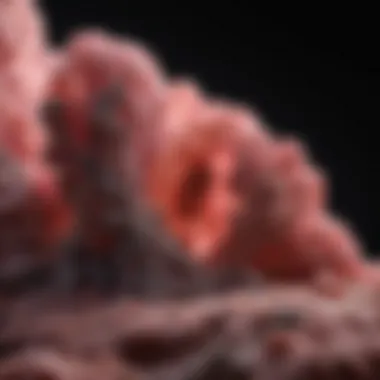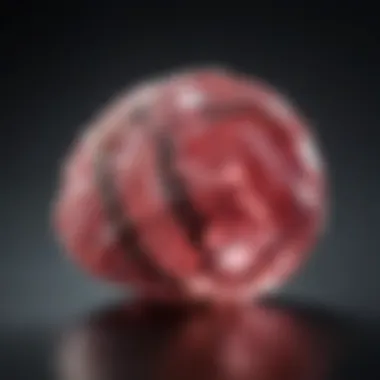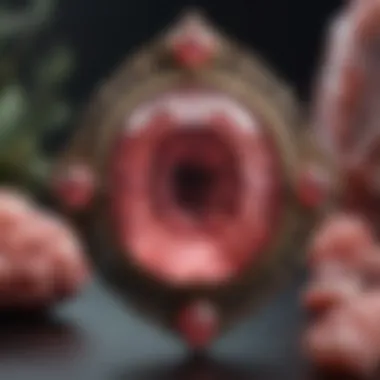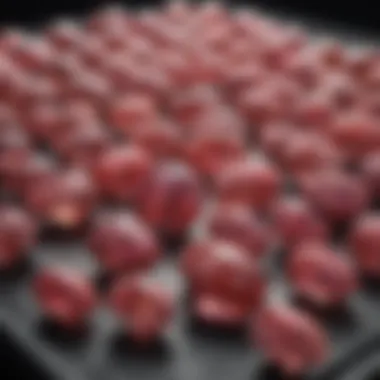Exploring Rhodochrosite: Properties and Significance


Intro
Rhodochrosite, a mineral known for its captivating pink tones, is much more than just a pretty face in the world of gemstones. This article will uncover the depths of rhodochrosite, showcasing its geological significance, historical narratives, and various applications. Whether you're in the business of designing jewelry, a seasoned collector, or just someone who appreciates the marvels of nature, understanding this mineral can add a rich layer of appreciation to your endeavors.
In this exploration, we'll delve into several key areas:
- The intricate formation processes that create rhodochrosite
- Its distinct physical and chemical properties that set it apart
- The historical importance and cultural resonance of this mineral across different civilizations
- Modern applications in both jewelry making and metaphysical practices
- Ethical sourcing practices that are increasingly relevant in today's market
Throughout this article, we aim to paint a vivid picture of rhodochrosite's multifaceted character, encouraging you to see beyond its stunning surface. Let’s embark on this journey together and discover the unique allure of this exceptional gemstone.
Prelude to Rhodochrosite
Rhodochrosite, with its alluring pink shades and rich history, draws curiosity from a diverse audience, from gemstone enthusiasts to geology aficionados. This mineral embodies not only striking aesthetics but also significant geological and cultural narratives that merit exploration. Understanding rhodochrosite goes beyond mere appreciation; it opens doors to comprehend Earth’s processes, cultural expressions, and even metaphysical beliefs.
Defining Rhodochrosite
Rhodochrosite is a rhombohedral carbonate mineral, primarily composed of manganese carbonate (MnCO₃). Its distinctive pink to red hues often give it the nickname "rosey mineral." The color variations reflect varying manganese content, leading to differing shades that range from a soft pastel to a vibrant fuchsia. When judging its value, the hue, clarity, and overall appearance play pivotal roles.
Moreover, rhodochrosite is cherished not just for its beauty but also for its relative softness, rated around 3.5 to 4 on the Mohs hardness scale, making it a unique gemstone for jewelry design, especially in more delicate settings. It’s not just a mineral; it’s a statement piece, often coveted for both its beauty and rarity.
Historical Overview
The history of rhodochrosite is as captivating as the mineral itself. First discovered in the mid-18th century in South America, its name is derived from the Greek words for "rose" and "to color," a nod to its vibrant pink shades. The Inca civilization revered this stone, treating it as a sacred gem, believing it to embody the blood of their ancestors. Much later, in the 19th century, it was extensively mined in places like the famous but now-closed sweetwater mine in Colorado, an area famed for producing some of the world’s most exquisite specimens.
"This mineral is more than just a collectible; it is a portal into the cultural and geological history of our planet."
Over the years, rhodochrosite has captivated not just collectors but also scientists. Rarely found in abundance, it’s often located alongside other minerals, making it both an exciting find for rock hounds and a subject of interest for geological studies. Its role in understanding the conditions under which certain geologic processes occur adds another layer of intrigue for those who study Earth’s natural history.
In summary, rhodochrosite is more than a pretty stone. Its defining characteristics and historical context illuminate its importance within both the mineral and cultural realms, paving the way for deeper exploration into its geological formation, variations, and the ongoing appreciation of its allure.
Formation and Geological Context
Understanding the formation and geological context of rhodochrosite offers vital insights into how this unique mineral comes into being. From its composition to the processes involved in its creation, every facet provides a deeper appreciation of rhodochrosite’s beauty and significance. This section navigates through the intricacies of mineral composition and the distinctive formation processes, laying a foundation for comprehending where and how rhodochrosite exists in nature.
Mineral Composition
At the heart of rhodochrosite lies its unique mineral composition, primarily consisting of manganese carbonate with the chemical formula MnCO₃. Unlike many other minerals, the presence of manganese gives rhodochrosite its characteristic pink to red hues, often reminiscent of delicate rose petals. This characteristic color is not just an aesthetic quality; it reflects the conditions under which the mineral formed.
- Key Components: The inclusion of iron or calcium can alter the color, but manganese remains paramount.
- Trace Elements: Other trace elements, though minimal, add to the mineral's complexity, influencing its overall properties.
Understanding the mineral composition aids not only in identification but also in appreciating rhodochrosite's varied applications, from decorative use in jewelry to its significance in geology. Recognizing these elements arms enthusiasts and collectors with knowledge critical for both valuation and care.
Formation Processes
The journey of rhodochrosite from mineral potential to breathtaking crystal is marked by two primary formation processes: hydrothermal sources and sedimentary formation. Each pathway results in unique characteristics that distinguish one specimen from another.
Hydrothermal Sources
Hydrothermal sources refer to the ways in which minerals crystallize from heated water solutions within the Earth’s crust. Rhodochrosite often forms in conditions of high temperature and pressure, typically in ore deposits from which it is mined.
- Characteristics of Hydrothermal Sources: The high-temperature fluids facilitate the significant mobility of manganese, allowing it to bond with carbonate ions. This results in the formation of well-defined, often spectacularly clear crystals that draw the eye.
- Advantages: This process allows for the development of crystals that can reach substantial sizes, making hydrothermally derived rhodochrosite particularly sought after.
However, these sources can also pose challenges, including variability in crystal quality due to fluctuating temperatures or pressures during formation.


Sedimentary Formation
Sedimentary formation involves the accumulation of sediments over time, where rhodochrosite often develops in evaporative environments or in association with other sedimentary minerals. Under the right conditions, layers of sediment build up in lakes or ocean beds, leading to the eventual crystallization of rhodochrosite from these deposits.
- Key Characteristics: This method tends to yield more opaque crystals, often with interesting banding or layering that adds to their visual appeal.
- Advantages: Specimens formed via sedimentation frequently contain fossils or other mineral inclusions, making them not just gemstones, but historical records that tell the story of their formation.
Despite its inherent beauty, sedimentary formation can be less predictable in terms of quality and rarity compared to hydrothermal sources.
"Each piece of rhodochrosite carries a history etched into its very structure, a testament to the conditions and processes that shaped it."
By exploring both hydrothermal and sedimentary processes, collectors and enthusiasts can gain a comprehensive view of rhodochrosite, significantly enriching their understanding and appreciation of this magnificent mineral.
Characterization of Rhodochrosite
Characterizing rhodochrosite involves a deep dive into its physical properties, varieties, and pricing. Understanding these elements is crucial for both enthusiasts and professionals, as it helps one appreciate the mineral's beauty and significance within geological and cultural contexts. By focusing on what makes rhodochrosite unique, we can uncover trends in collecting and valuation that are pertinent to those engaged in its trade or display.
Physical Properties
Color Variations
One of the most striking features of rhodochrosite is its vibrant colors, which range from soft pinks to rich reds and even shades of white and brown. These color variations are determined by the mineral's composition, as trace elements can influence its hue. For instance, the presence of manganese gives rhodochrosite its pink color, while variations in iron can lead to more reddish tones.
A key characteristic of these color variations is their impact on rhodochrosite's desirability as a gemstone. Collectors and jewelers often seek out stones with more saturation and uniformity in color, as they make for more visually appealing pieces.
- Unique Features: The color intensity can be an indicator of the gem's quality and potentially its value. For example, deep pink rhodochrosite is usually more sought-after.
- Advantages/Disadvantages: While vivid colors enhance aesthetic appeal, they can also lead to higher asking prices, putting them out of reach for some collectors.
Hardness and Luster
The hardness and luster of rhodochrosite also play a significant role in its characterization. On the Mohs scale, rhodochrosite typically rates around 3.5 to 4, making it relatively soft compared to other gemstones. This soft nature is notable for its impact on durability; while it can take a nice polish, it is also susceptible to scratching and wear, particularly in jewelry settings.
- Key Characteristic: Rhodochrosite possesses a vitreous to pearly luster, which can enhance its appearance when cut and polished.
- Unique Features: The luster often brings out the mineral's colors, making it more striking in craftsmanship.
- Advantages/Disadvantages: Its softness is a double-edged sword. While it allows for intricate carvings and designs, careful handling is necessary to prevent damage.
Varieties and Pricing
Rhodochrosite comes in various forms: from natural stones that are uncut to beautifully crafted cabochons and beads. Each variety attracts different collectors and users.
Some of the most recognized types include:
- Mangano Rhodochrosite: A variant known for its lovely pastel pink color with white banding.
- Desert Rose Rhodochrosite: Featuring intriguing patterns and unique formations, appealing to collectors who appreciate geological artistry.
The pricing of rhodochrosite is generally influenced by color saturation, size, cut, and clarity. Understanding these factors is essential for collectors as they navigate the market. Collectors often pay a premium for rare color patterns or high-quality cuts due to their special properties.
As the interest in this mineral grows, it is paramount for enthusiasts to keep an eye on trends to ensure they make informed purchases, reflecting an understanding both of aesthetic appeal and market value.
Cultural Significance
The cultural significance of rhodochrosite is as multifaceted as the mineral itself. Beyond its alluring pink shades, rhodochrosite has been intertwined with various cultures throughout history, serving multiple purposes. This section delves into its historical uses and modern references that continue to shape the perceptions and applications of this mineral.
Cultural Uses in History
In historical contexts, rhodochrosite held considerable value. The Incas regarded it as the blood of their ancestors, believing it had divine properties. It was often carved into intricate designs, with some artifacts showcased in ceremonial practices. The vibrant colors were thought to embody vitality and love, making it integral in the rituals of various South American tribes.
Similarly, in the 19th century, miners in the U.S. appropriated rhodochrosite as a symbol of their industrious spirit. They would often carry pieces of it as a good luck charm, believing it would protect them. Many communities in mining regions celebrated this unique mineral by incorporating it into local art and craftworks, bridging natural beauty and human creativity.
“Rhodochrosite is not just a rock; it tells stories of our past, interweaving human life and natural formation.”


Modern Cultural References
Jumping to contemporary times, rhodochrosite has found its place in popular culture. Many jewelry designers draw inspiration from its visual appeal, showcasing it in pieces celebrated for both their beauty and the energy attributed to the stone. In various healing practices, crystal enthusiasts utilize rhodochrosite not just as a adornment but as a tool for emotional healing and balance. This connection to wellness has established it as a modern favorite among spiritual communities.
In addition, art installations and crafts featuring this mineral are becoming more popular. As a unique decorative element, rhodochrosite often appears in contemporary art pieces, symbolizing love, compassion, and self-healing.
In terms of media, references to rhodochrosite can be found on social platforms like Reddit or Facebook, where enthusiasts gather to share their collections, experiences, and the metaphysical attributes they believe it carries.
Thus, rhodochrosite, with its rich history and potent modern connections, remains a significant cultural artifact that continually evolves, adapting to contemporary values while retaining its historical roots.
Metaphysical Properties
The metaphysical properties of rhodochrosite serve as a fascinating component within the broader understanding of this striking mineral. Many believe that beyond its aesthetically pleasing appearance, rhodochrosite holds a treasure trove of potential benefits, particularly in emotional and energetic realms. This section delves into the essence of these benefits, examining how this mineral might be utilized not only in personal development but also in holistic practices.
Healing Attributes
Emotional Healing
Rhodochrosite is often hailed for its role in emotional healing. It is characterized by its ability to foster love and compassion, providing a soothing presence to those encountering emotional turmoil. This mineral can help individuals reconnect with suppressed feelings, offering a pathway to self-acceptance and emotional strength.
Its key characteristic lies in its gentle yet powerful vibrational energy, which many claim aids in releasing negative emotional patterns. By allowing individuals to face past traumas with a sense of awareness and calm, rhodochrosite becomes a favorable choice for those seeking emotional balance.
The unique feature of rhodochrosite's emotional healing capability is its capacity to promote forgiveness—towards oneself and others. As such, its advantages can be profound, fostering personal growth, a sense of inner peace, and improved relationships. However, there’s a notion that it requires some patience and openness to truly benefit from its characteristics, which might pose a challenge for those looking for quick emotional fixes.
Energy Balancing
In the realm of energy balancing, rhodochrosite is touted for its ability to harmonize the heart chakra, merging emotional and physical energies. This mineral is considered a powerful ally for those who feel energetically misaligned, offering revitalization and renewed vigor.
The core aspect of rhodochrosite in energy balancing is its ability to help individuals cultivate a deeper understanding of their own energies, enabling them to navigate life’s ups and downs with greater clarity. This characteristic makes it a popular choice among those looking to balance both their personal energies and those within their environment.
One noteworthy feature of rhodochrosite’s energy balancing abilities is its reputed effectiveness in counteracting stress. This makes it advantageous for those in high-pressure situations, as it can promote a sense of calm. However, an element to consider is that, like the process of emotional healing, energy balancing may not yield instant results, emphasizing the importance of consistent practice and integration into one’s routine.
Meditative Uses
When it comes to meditative uses, rhodochrosite is often incorporated into practices designed to enhance mindfulness and spiritual connection. Many individuals find that meditating with rhodochrosite can elevate their experiences, leading to deeper states of relaxation and introspection. This stone is particularly valued in guided meditations or self-reflection sessions.
In this context, rhodochrosite may be used as a tool to quiet the mind, allowing thoughts to flow without judgment. Users report a noticeable enhancement in their meditation practices, noting that the emotional healing benefits carry over and encourage a more profound connection to one’s spirit.
As practitioners explore various meditative techniques, rhodochrosite serves as both a focus point and a reminder of inherent love and compassion, encouraging not just personal growth but a collective consciousness of healing within communities.
Rhodochrosite, both a tool for healing and a beacon of emotional strength, embodies the profound journey of self-discovery.
In summation, the metaphysical properties of rhodochrosite present an intricate relationship between physical presence and emotional impact, making it a subject of rich exploration for enthusiasts and practitioners alike.
Ethical Sourcing and Environmental Impact
The conversation surrounding rhodochrosite cannot be complete without bringing up the pressing issue of ethical sourcing and its environmental implications. As more gemstone enthusiasts and collectors become aware of the sources of their precious stones, it is crucial to address the broader context of mining practices that can significantly affect local communities and ecosystems.
Sourcing rhodochrosite sustainably is not just a responsibility; it’s a necessity. As stewards of the Earth, gemstone collectors, and jewelry designers have the power to influence how materials are mined and sold. In this section, we’ll explore the challenges that come with mining practices and discuss sustainable alternatives that are beginning to surface in the industry.
Challenges in Mining Practices
Mining rhodochrosite often comes with numerous challenges. Some of the most significant concerns include:


- Environmental Degradation: Traditional mining techniques can lead to habitat destruction, soil erosion, and even pollution of nearby water sources. This disrupts local ecosystems and can prove detrimental to wildlife and vegetation.
- Labor Issues: In many regions where rhodochrosite is harvested, miners may work in dangerous conditions, often without the necessary safety protocols. This can lead to severe injuries and even fatalities.
- Regulatory Gaps: In some countries, there may be insufficient governmental oversight concerning mining operations. This absence of regulation can result in exploitation of natural resources without consideration for sustainability and ethical standards.
"The extraction of rhodochrosite should be done with an eye toward the future, ensuring that the impacts are minimal not just for today but for generations to come."
To tackle these issues effectively, many stakeholders are calling for a more transparent supply chain in the minting and trading of gemstones. This means insisting on certifications and traceability in sources to reassure consumers that their purchases are ethically obtained.
Sustainable Alternatives
Embracing sustainable alternatives in the sourcing of rhodochrosite is essential for fostering responsible mining practices. These alternatives not only help in mitigating the adverse effects associated with mining but also create a more conscientious market. Here are some approaches gaining traction:
- Artisanal Mining: Supporting small-scale, artisanal mining operations can often present a more sustainable approach. These operations typically have a smaller footprint and involve community members, leading to better living conditions and awareness of safety.
- Recycled Gemstones: There’s a growing trend in the jewelry industry towards using recycled gemstones. By repurposing stones from older jewelry pieces, artisans and collectors can reduce the demand for new mining, thus encompassing sustainability while promoting unique designs.
- Responsible Certification Programs: Programs that certify gemstones as ethically sourced, such as the Responsible Jewellery Council, are becoming more prevalent. These certifications provide assurance that the stones were mined and processed with respect for human rights and environmental standards.
- Community Engagement Projects: Many organizations are now working directly with local mining communities to promote better practices and provide educational resources. These efforts can lead to more sustainable mining practices and improved living conditions for workers.
Rhodochrosite in Gemstone Collections
Rhodochrosite holds a distinctive place in gemstone collections due to its vibrant coloration and unique formation, making it a sought-after piece among collectors and jewelry enthusiasts. The allure of this mineral lies not only in its aesthetic appeal but also in the story that each specimen carries. The beautiful pink to reddish-pink hues range from subtle pastel tones to bright, saturated colors, capturing the eye and evoking a sense of elegance and rarity.
Historically, rhodochrosite has been revered by diverse cultures for its beauty and properties, often regarded as a symbol of emotional healing and love. Its rarity, particularly in fine form, is another factor that boosts its desirability among collectors. Renowned for its striking banded patterns, each specimen becomes a unique work of art, often likened to the masterful strokes of a painter's brush. With such beauty, rhodochrosite not only decorates showcases but also enhances the stories that collectors love to share with fellow enthusiasts.
Valuation and Appraisal
Valuation of rhodochrosite can vary greatly based on several key factors. Color, clarity, and size are fundamental when determining the worth of a piece. A deeper pink hue combined with clearer stones typically commands higher prices. The presence of unique banding and patterns adds further value, reminiscent of natural artistry spun by time. Collectors should keep a few points in mind:
- Rarity: Fine specimens with outstanding color and minimal inclusions are rare.
- Market Trends: The demand for rhodochrosite fluctuates, as it sometimes garners popularity within the collector community.
- Quality vs. Price: It's important to establish a balance between acquiring quality stones and managing budget constraints.
When appraising rhodochrosite, consider establishing relationships with reputable gemologists or appraisal services to accurately assess value.
Collecting and Trading Insights
As a collector, understanding the nuances of trading rhodochrosite is crucial. This gemstone is not just a decorative piece; it embodies a journey of exploration, learning, and networking. When considering the collection of rhodochrosite, be mindful of the following:
- Authenticity: Always verify the source, as imitations can crop up. Engaging with trusted dealers can safeguard against acquiring synthetic materials.
- Community Engagement: Join online forums like Reddit to connect with fellow enthusiasts who share their experiences, trades, and insights. Engaging in discussions can provide valuable understanding about market dynamics.
"Every piece of rhodochrosite carries with it not just mineral properties, but stories that connect us to the Earth's history and the very hands that sought it out."
- Preservation: Proper care and storage are crucial. Rhodochrosite is relatively soft (around 3.5 to 4 on the Mohs scale) and can be scratched easily. Keeping it in a soft cloth or separate compartments within a jewelry box prevents damage and preserves its beauty.
Trading rhodochrosite may also open doors to other mineral trades. Building networks with other rock and mineral enthusiasts can lead to opportunities for exchanges, sharing insights or pursuing both personal and professional interests in gemstones.
In summary, rhodochrosite's vibrant presence in gemstone collections is a valuable testament to its beauty and historical importance. Collectors who appreciate the depth and history associated with this mineral can not only enhance their collections but also forge connections within the vibrant community of gemstone enthusiasts.
Closure
In summarizing the vast explorations of rhodochrosite, it becomes evident that this mineral is more than just a pretty stone; it is a captivating narrative of geological formations, cultural significance, and spiritual importance. Emphasizing its unique formations and striking colors, rhodochrosite serves as a potent reminder of Earth's exquisite natural artistry. The various contexts in which this gemstone is embedded enrich the discourse surrounding it, offering a lens into history while simultaneously suggesting pathways for future exploration and sustainability.
Summary of Insights
The insights gathered throughout this article underscore several key points:
- Geological Significance: Rhodochrosite forms under specific mineral conditions, often linked to hydrothermal processes, showcasing the planet's geological diversity.
- Cultural Value: This mineral holds profound meaning in different societies, often used in jewelry and even believed to bestow healing properties.
- Metaphysical Aspects: The belief in the emotional healing and energy balancing properties of rhodochrosite elevates it beyond mere ornamental use, appealing to those interested in holistic practices.
- Ethical Considerations: Increased awareness around sustainable mining practices ensures that collectors can appreciate rhodochrosite with a clear conscience, fostering a balance between beauty and responsibility.
"Rhodochrosite stands at the intersection of earth's artistry and the human experience, a captivating gemstone that resonates on multiple levels."
Future Perspectives
Looking ahead, the future of rhodochrosite in both jewelry and the geological community is ripe with potential:
- Research Opportunities: Continued studies on its geological formation could unlock further secrets about our planet's history and mineral composition, offering insights that are yet to be uncovered.
- Sustainable Practices: The development of stricter ethical standards in sourcing rhodochrosite could pave the way for a more responsible trade, ensuring that future generations can enjoy its beauty without adverse effects on the environment.
- Technological Evolution: As technology advances, new methods for cutting and enhancing rhodochrosite may emerge, creating novel designs that can captivate an even broader audience.
- Cultural Integration: As awareness of its metaphysical properties grows, rhodochrosite might find a deeper foothold within wellness and holistic practices, merging ancient beliefs with modern healing methods.
Ultimately, rhodochrosite is poised to continue its journey as both a cherished gem and a subject of scientific intrigue. The intersection of its multifaceted origins means it will remain a topic of interest for gem enthusiasts, collectors, and scholars alike.



